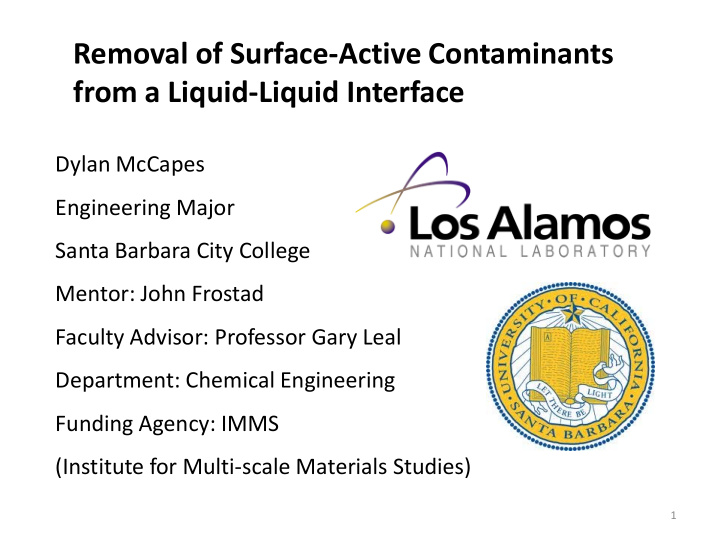



Removal of Surface-Active Contaminants from a Liquid-Liquid Interface Dylan McCapes Engineering Major Santa Barbara City College Mentor: John Frostad Faculty Advisor: Professor Gary Leal Department: Chemical Engineering Funding Agency: IMMS (Institute for Multi-scale Materials Studies) 1
Outline • Purpose of study • Experiments • Design for apparatus 2
What are Surfactants? http://www.perfumezilla.com/maja/maja-soap/ 3 http://en.wikipedia.org/wiki/Langmuir%E2%80%93Blodgett_film
What is Coalescence? Significantly slower than real time 4
Stability of Foams and Emulsions http://irwan.net/tempurpedic-mattress/ http://www.nasa.gov/externalflash/135_splash/index.ht ml 5
Gathering data using a tensiometer Torsion Arm Du-nouy ring Du Nouy Ring Fisher Tensiometer Torsion Arm 6
Isotherm for HTAB in Polydimethylsiloxane/Water System 7
Flat Interface Removal Experiment Removing interface using a syringe 8
Surfactant Removal System Create a device to remove interface • 1. Maximize surface area to volume ratio 2. Control drop size 3. Measure interfacial tension within device 9
Apparatus Design Valve system for pendant Harvard Apparatus drop/jet stream and ejection Pendant/ Ejection Jet valve stream hole 10
Future Goals • Test prototype apparatus • Build a patentable apparatus 11
Summary • Surfactant removal is important for coalescence study • HTAB isotherm is used to determine HTAB concentration from interfacial tension • Flat interface removal experiment verifies idea behind apparatus • Valve system with pendant drop/jet stream hole and eject valve 12
Thank You 13
Recommend
More recommend